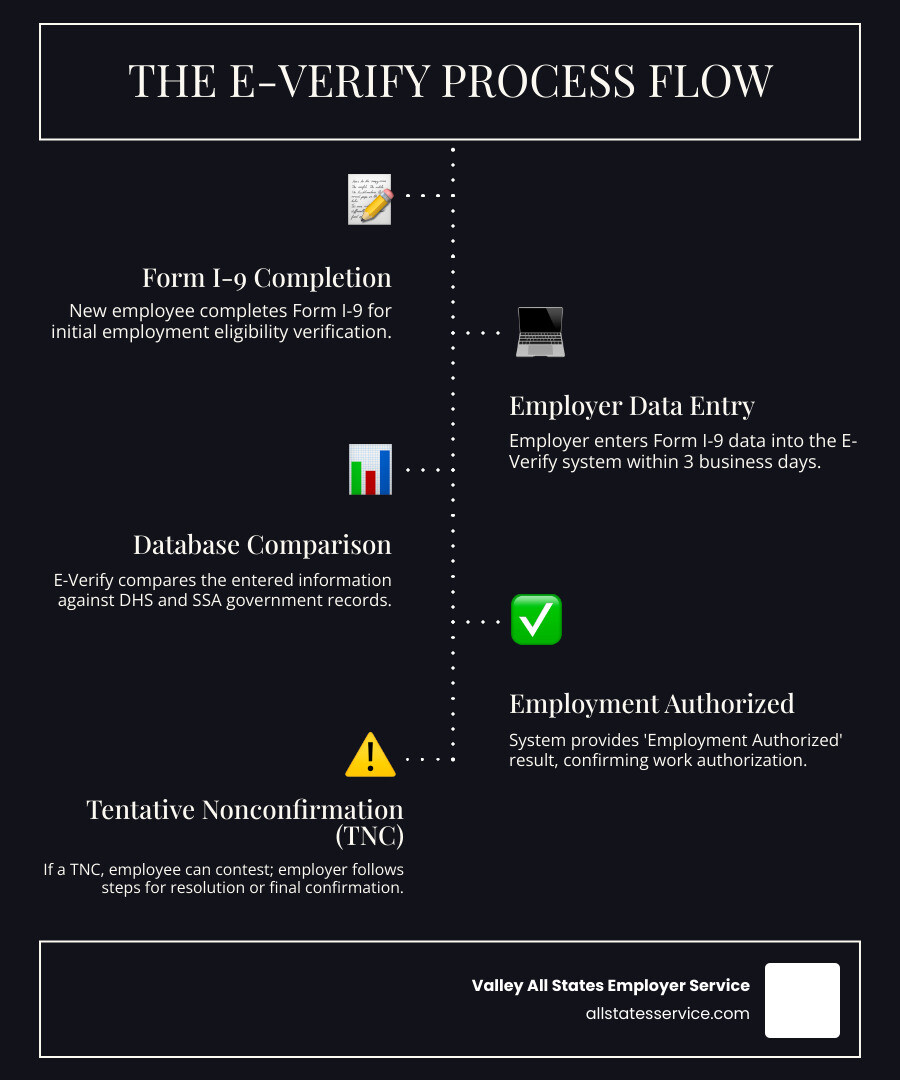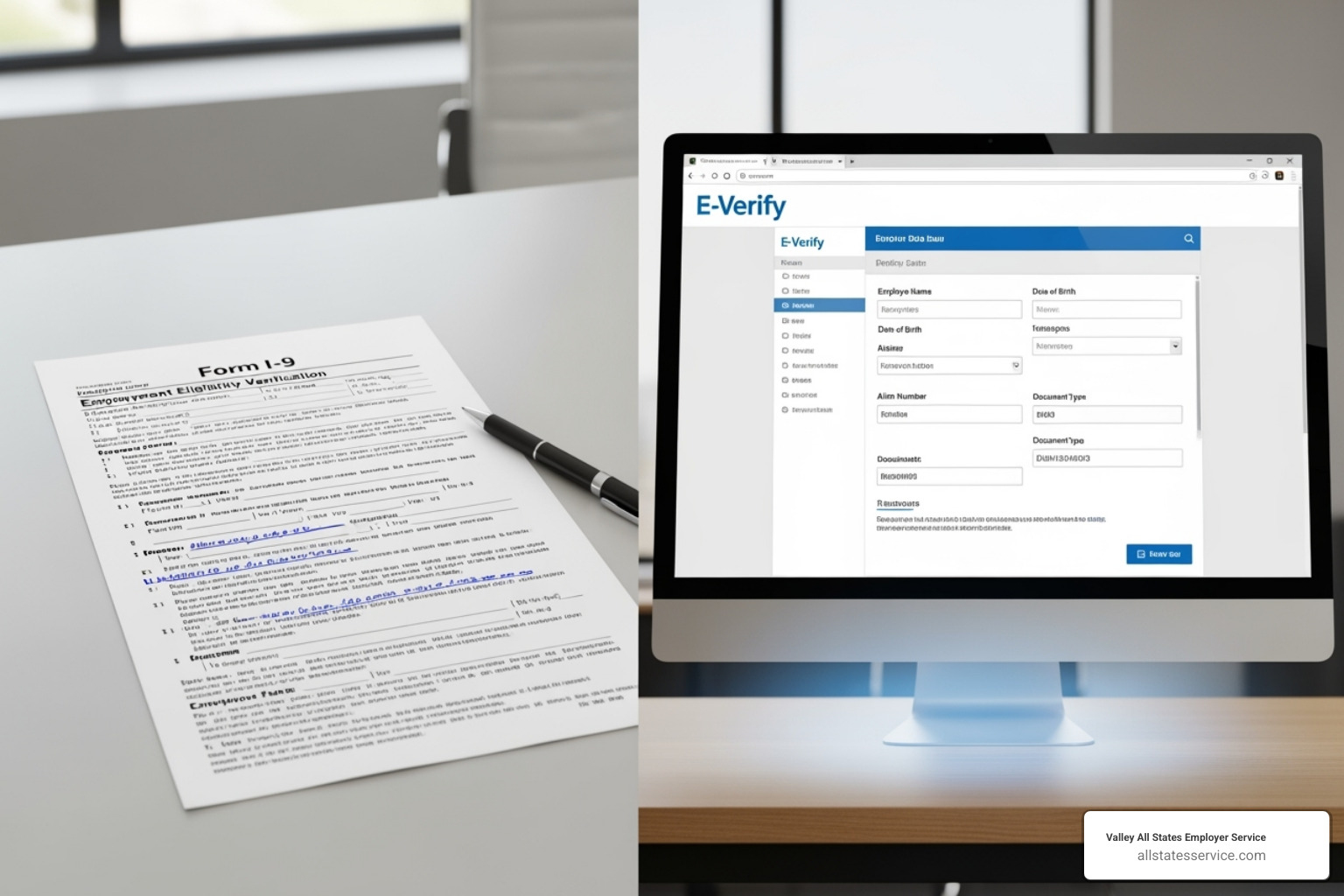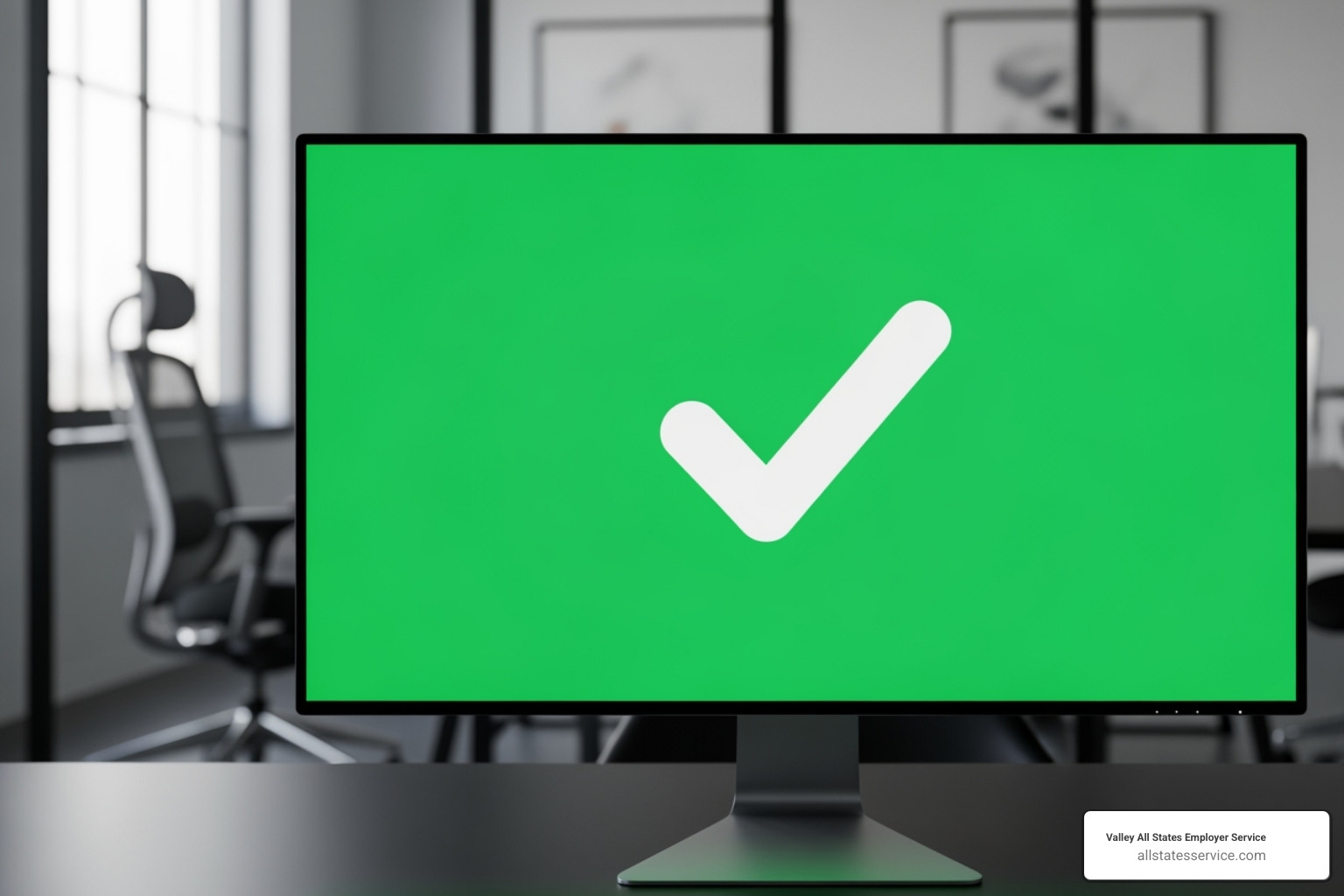What is e verify: Master I-9 2025
Understanding the Foundation of Employment Eligibility Verification
What is E-Verify is a question many employers face when navigating complex hiring regulations. E-Verify is a free, internet-based system operated by the Department of Homeland Security (DHS) in partnership with the Social Security Administration that allows employers to confirm their employees’ eligibility to work in the United States.
Quick Answer: E-Verify Basics
- What it is: An electronic system that compares employee information from Form I-9 against government records
- Who runs it: Department of Homeland Security and Social Security Administration
- Cost: Free for all employers
- Speed: Results provided within 3-5 seconds
- Purpose: Confirms work authorization after completing Form I-9
As of May 2023, E-Verify has processed over 48 million cases with a 98.88% approval rate for work-authorized employees. More than 700,000 employers currently use the system.
For HR managers drowning in compliance requirements, understanding E-Verify and its relationship with Form I-9 isn’t optional anymore. Whether you’re a federal contractor required to use the system or considering voluntary participation, the interplay between these two verification processes forms the backbone of legal workforce management.
The system works as a supplement to Form I-9, not a replacement. After an employee completes their I-9, employers enter that same information into E-Verify, which then cross-references it against millions of government records. This electronic verification happens in seconds, but the implications for your business last much longer.

What is E-Verify and How Does It Relate to Form I-9?
Think of what is E-Verify as the digital partner to your paper Form I-9. It’s an internet-based system that takes the employment eligibility verification process into the 21st century. The Department of Homeland Security (DHS) and Social Security Administration (SSA) built this free tool to help employers like you confirm that new hires are legally authorized to work in the United States.
Here’s where it gets interesting: E-Verify doesn’t replace Form I-9. Instead, it acts as a powerful backup singer to I-9’s lead vocals. You still need to complete the traditional I-9 process first, then E-Verify electronically double-checks that information against massive government databases. It’s like having a fact-checker review your homework, except this one has access to millions of federal records and works at lightning speed.
The beauty of this partnership lies in its simplicity. Federal law requires every employer to complete Form I-9, but E-Verify takes that same data and gives you an electronic confirmation within seconds. We explore this relationship in much more detail in our guides on What is an I-9? and E-Verify and I-9.

The Role of Form I-9: The Cornerstone of Verification
Before diving deeper into what is E-Verify, let’s talk about its foundation: Form I-9. This isn’t just another piece of paperwork cluttering your desk. It’s the cornerstone document that every U.S. employer must complete for every single new hire, whether they’re a lifelong citizen or someone who just got their work authorization yesterday.
Form I-9 follows a straightforward two-step dance. First, your employee fills out Section 1, where they provide personal information and make a legal promise that they’re authorized to work in the U.S. They also check a box indicating their immigration status. No employer involvement here, just the employee and their pen.
Then comes your turn with Section 2, where you become a document detective. You’ll physically examine the original documents your employee brings in. These fall into three categories: List A documents that prove both identity and work authorization (like a U.S. passport), List B documents that establish identity only (think driver’s license), and List C documents that show work authorization only (like a Social Security card). Your job is making sure these documents look genuine and actually belong to the person standing in front of you.
This legal requirement for all hires sets the stage for everything that follows. Our comprehensive I-9 Form Completion guide walks you through every detail of getting this critical step right.
How the E-Verify System Works
Once you’ve completed Form I-9, E-Verify transforms into your digital verification partner. You take the same information from that I-9 and feed it into the system, where the real magic happens through electronic comparison with government records.
The process moves fast. You enter your employee’s name, date of birth, Social Security Number, and other key details from their I-9. E-Verify immediately sends queries racing through the SSA database to verify that Social Security information and shoots another query to the DHS database to confirm immigration status and identity documents.
Within three to five seconds, you get instant results. Most of the time, you’ll see “Employment Authorized” and you’re done. The system just gave you confirmation of work authorization backed by millions of government records. If something doesn’t match up, you’ll get a “Tentative Nonconfirmation” instead, which starts a different process we’ll cover later.
This speed and reliability make E-Verify what we call an Automated Eligibility Verification System. It takes the guesswork out of employment verification and gives you confidence that you’re building a legally compliant workforce.
The E-Verify Process: A Step-by-Step Guide for Employers
Getting started with what is E-Verify doesn’t have to feel overwhelming. Think of it like setting up any new business system. There’s an initial setup phase, then a routine process you’ll follow for every new hire. Once you get the hang of it, the whole thing becomes second nature.
The key to E-Verify success lies in understanding the enrollment process, following proper timelines, and maintaining accurate record keeping. Our comprehensive resources on E-Verify Employer Requirements break down everything you need to know to stay compliant and avoid costly mistakes.

Step 1: Enrolling in the E-Verify Program
Before you can verify anyone’s work eligibility, you need to become an enrolled E-Verify employer. This involves more than just creating an account. You’re entering into a formal agreement with the government about how you’ll handle employment verification.
The Memorandum of Understanding (MOU) is your contract with the Department of Homeland Security. When you sign this document electronically, you’re agreeing to use E-Verify properly and consistently. Don’t worry about the legal language being too complex. The MOU clearly outlines what you can and cannot do with the system.
You’ll start by visiting the E-Verify website and working through their enrollment process. Every person who will access your E-Verify account must complete the user tutorial before they can start creating cases. This isn’t busy work. The tutorial teaches you exactly how to avoid the common mistakes that lead to compliance problems.
If your business has multiple locations, you can designate a Corporate Administrator role to manage all your sites from one central account. This makes oversight much easier for larger companies. You can also enroll in the program on the USCIS website to get started immediately.
Small business owners often worry that E-Verify will be too complicated for their operations. The truth is, once you understand the basics, it’s quite straightforward. We’ve created special guidance on E-Verify for Small Businesses to help smaller employers steer the system without getting bogged down in unnecessary complexity.
Step 2: Creating a Case for a New Hire
Here’s where the rubber meets the road. After enrollment comes the actual work of verifying your employees. The most important thing to remember is timing. You have exactly three business days after an employee starts work for pay to create their E-Verify case. This three-day rule isn’t a suggestion. It’s a federal requirement.
Let’s say you hire someone who starts on Monday. You need to submit their E-Verify case by Thursday at the latest. Missing this deadline can result in penalties, so many employers create cases immediately after completing the I-9 to avoid any timing issues.
Post-hire verification is crucial to understand. You cannot run E-Verify checks on job applicants or use the system for pre-employment screening. The employee must have accepted your job offer, completed their Form I-9, and started working before you can verify them through E-Verify.
The information from Form I-9 flows directly into your E-Verify case. You’ll enter the employee’s name exactly as it appears on their I-9, along with their date of birth, Social Security Number, and the documents they presented. Accuracy matters tremendously here. Even small typos can trigger unnecessary complications.
Submitting the case happens through the E-Verify web portal. Most of the time, you’ll get results within seconds. The system compares your employee’s information against millions of government records to confirm their work authorization.
Sometimes you’ll encounter pending SSNs when employees have applied for a Social Security Number but haven’t received it yet. These workers can still start their jobs, but you’ll need to create their E-Verify case once they provide their SSN. The system has specific options for handling these situations.
Many employers find that working with an E-Verify Employer Agent eliminates the stress of managing timelines and data entry. We handle the entire process from start to finish, ensuring every case is submitted accurately and on time.
E-Verify Mandates: Is Participation Required for Your Business?
Here’s where what is E-Verify gets a bit tricky for business owners. The short answer? It depends on who you are and where you operate.
For most employers across the United States, E-Verify participation remains voluntary. You can choose to use it as an extra layer of verification, but you’re not legally required to do so. However, and this is a big however, there are some significant exceptions that might make E-Verify mandatory for your business.
Think of it like speed limits. Most roads have suggested speeds, but certain areas like school zones have strict requirements. E-Verify works similarly, with specific circumstances that trigger mandatory participation. Understanding these mandates isn’t just helpful for compliance planning, it’s essential for avoiding costly penalties down the road.
The complexity of these requirements is exactly why we created our comprehensive guide on Federal E-Verify Rules. Let’s break down when you absolutely must use E-Verify.
Federal Contractors and Agency Rules
If your business works with the federal government, you’re likely already familiar with layers of compliance requirements. E-Verify is often one of them.
The FAR E-Verify clause appears in many federal contracts and subcontracts. When this clause is included in your contract, E-Verify shifts from optional to absolutely required. You’ll need to verify all new hires, and in some cases, existing employees who work directly on the federal contract.
Here’s what catches many businesses off guard: subcontractors aren’t exempt. The E-Verify requirement often flows down through the contracting chain. So even if you’re not the prime contractor, you might still be bound by these rules.
The stakes are high with federal contracts. Compliance requirements aren’t suggestions, they’re contract terms. Miss them, and you’re looking at penalties that can include contract termination. That’s a risk most businesses simply can’t afford.
We’ve seen enough federal contractors struggle with these requirements that we developed a specialized resource: E-Verify Essentials Every Federal Contractor Should Master. It covers everything you need to know to stay compliant without the headaches.
State-Specific Mandates and Local Ordinances
State laws add another layer of complexity to the E-Verify landscape. What’s required in Arizona might be prohibited in California, creating a patchwork of regulations that can make your head spin.
Many states start with public employers, requiring state and local government agencies to use E-Verify for their hiring. This makes sense from a policy perspective, as government entities want to ensure they’re setting an example for legal workforce practices.
The requirements often extend to public contractors as well. If you bid on state or local government projects, you’ll likely encounter E-Verify mandates in the contract terms. It’s becoming as common as insurance requirements in many jurisdictions.
Some states take it further, extending mandates to private employers based on factors like company size or industry. The specific requirements vary dramatically by state, which is why staying current on local laws is so important.
States with some form of E-Verify mandates include Alabama, Arizona, Florida, Georgia, Idaho, Indiana, Louisiana, Mississippi, Missouri, Nebraska, North Carolina, Oklahoma, Pennsylvania, South Carolina, Tennessee, Utah, and Virginia. But remember, the devil is in the details. Each state’s requirements differ in scope, timing, and enforcement.
What makes this even trickier is that some states, like California, have laws that actually limit when local governments can require E-Verify use by private employers. It’s a complex web that requires careful navigation.
For a broader perspective on how these policies developed, check out this helpful resource: An Overview of E-Verify Policies at the State Level. And if you’re operating in specific states, we have targeted guidance like our Employment Verification Maryland resource.
The bottom line? This complex regulatory landscape is exactly why many businesses turn to expert HR compliance assistance. It’s much easier to focus on running your business when you know the compliance details are handled correctly.
Understanding E-Verify Outcomes: From Confirmation to a TNC
Once you submit an E-Verify case, you’ll receive one of three possible outcomes. Think of it like getting your test results back, each one telling you something different about your employee’s work authorization status. Understanding these results isn’t just about checking a compliance box. It’s about protecting both your business and your employees’ rights. Our E-Verify Status Check services help you monitor these results and respond appropriately every time.
Most employers find the system surprisingly fast. Within seconds, you’ll see your result displayed on screen. But what is E-Verify actually telling you with each outcome? Let’s break down what each result means and what you need to do next.

“Employment Authorized”: The Ideal Result
Getting an “Employment Authorized” result feels like hitting a green light. This means the employee’s information from their Form I-9 perfectly matches what’s in the government databases. Your new hire is confirmed as eligible to work in the United States.
When you see this result, your job becomes refreshingly simple. The case closure happens automatically, and no further action is required from you regarding that specific verification. You can breathe easy knowing this employee is good to go.
However, don’t forget the paperwork side of things. You must record the E-Verify case number directly on the employee’s Form I-9 or print the case details and file them with the I-9. This step is crucial for audit purposes and demonstrates your compliance efforts. Proper I-9 Record Keeping protects your business during government audits and keeps everything organized.
This result represents the smooth path through employment verification. Your employee can continue working with full confidence in their authorization status, and you can focus on helping them succeed in their new role.
The TNC Process: A Guide to Resolving Mismatches
Sometimes E-Verify hits a snag, resulting in a “Tentative Nonconfirmation” or TNC. Before you panic, understand this important fact: a TNC doesn’t mean your employee is unauthorized to work. It simply means the information didn’t match what’s currently in the government databases.
Think of a TNC like a mismatch notification that needs attention. Maybe the employee’s name in the Social Security Administration records differs slightly from what they wrote on their I-9. Perhaps their immigration status hasn’t been updated in the system yet. These mismatches happen more often than you might think.
Here’s where employee rights become critically important. You must inform the employee about the TNC and provide them with a “Further Action Notice.” This notice explains their options and rights. The employee decision to contest belongs entirely to them. You cannot pressure them either way.
If your employee chooses to contest the TNC, they typically have eight federal government workdays to contact the relevant agency (either SSA or DHS) to resolve the discrepancy. During this entire period, the employee can continue working normally. This protection ensures that database errors don’t unfairly impact someone’s livelihood.
Pay close attention to prohibited employer actions during this period. You cannot fire, suspend, delay training, or take any other adverse action against an employee solely because they received a TNC. This is especially true if they choose to contest it. Violating these rules can lead to serious discrimination claims and hefty I-9 Compliance Penalties.
The resolution process varies depending on the issue. If the employee successfully resolves the discrepancy with the appropriate agency, their case will eventually update to “Employment Authorized.” If they choose not to contest or cannot resolve the mismatch, the case becomes a “Final Nonconfirmation,” which typically means the employment relationship must end.
Understanding employee rights during this sensitive process protects everyone involved. The USCIS Employee Rights Toolkit provides comprehensive information that both employers and employees should review. We help you steer these delicate situations with the care and expertise they deserve, ensuring compliance while treating employees fairly throughout the process.
Frequently Asked Questions About E-Verify
We hear the same questions over and over from employers trying to wrap their heads around what is E-Verify and how it’ll shake up their day-to-day operations. Let’s tackle the big ones that keep coming up in our conversations with clients.
What are the main benefits and drawbacks of using E-Verify?
Every system has its ups and downs, and E-Verify is no different. The reality is that while it solves some major headaches for employers, it can create a few new ones too.
On the bright side, E-Verify dramatically increases your compliance confidence. You’re building a legal workforce and slashing the risk of those painful penalties that come with hiring unauthorized workers. The system also acts as a natural deterrent, which means fewer unauthorized individuals even attempt to seek employment with E-Verify employers.
The speed factor is pretty impressive too. Getting results in 3-5 seconds beats waiting days or weeks for traditional background checks. Plus, it’s completely free to use, and it helps protect jobs for workers who are actually authorized to be here.
But let’s be honest about the challenges. The administrative burden is real. Someone on your team needs to create cases, handle TNCs when they pop up, and keep everything properly documented. Even with E-Verify’s high accuracy rate of 98.88%, data entry mistakes or outdated government records can still trigger those frustrating Tentative Nonconfirmations.
Privacy concerns make some employees nervous about sharing sensitive information with government databases. There’s also the risk that employers might misuse the system or discriminate against certain groups, which is why following proper procedures is so crucial.
The system only works for new hires in most cases, so it won’t help you verify your existing workforce unless you’re required to do so. And remember, E-Verify confirms work authorization but it’s not a background check. It won’t tell you if someone’s actually qualified for the job.
For employers wondering what is E-Verify, how does it impact F-1 STEM OPT students?
Here’s where E-Verify becomes absolutely critical for a specific group of workers. If you’re hiring F-1 students who want that coveted 24-month STEM OPT extension, your company must be enrolled in E-Verify. No exceptions, no workarounds. It’s a hard requirement.
Students pursuing STEM fields need this extension to gain valuable work experience in the U.S., but they can only get it if their employer uses E-Verify. This means these talented graduates are actively seeking out E-Verify employers, which could give you access to a motivated, highly-educated talent pool.
Smart students often use myE-Verify tools before they even start job hunting. The Self Check feature lets them verify their own government records are accurate, potentially preventing TNCs before they happen. The Self Lock feature helps protect their Social Security Number from employment-related identity fraud.
For employers, this creates an interesting dynamic. Being E-Verify enrolled might actually help you attract top STEM talent who need compliant employers to continue their careers in the United States. You can learn more about these student tools on the official myE-Verify website.
Beyond what is E-Verify, what are the key privacy concerns for employees?
Let’s address the elephant in the room. Some employees get nervous about E-Verify, and their concerns aren’t entirely unfounded.
Data security tops the list of worries. The system compares personal information against massive government databases, and employees wonder who else might access this data or what happens if there’s a security breach. While the government maintains strict security protocols, the concern is understandable.
Even with high accuracy rates, government record errors can create problems for completely authorized workers. Imagine being told you can’t work because of a clerical error in a database somewhere. It’s frustrating and feels invasive, especially when correcting these errors takes time and effort.
Identity theft protection presents a double-edged sword. While E-Verify aims to prevent identity theft, the system inherently requires sharing Social Security Numbers and other sensitive identifiers. Tools like myE-Verify’s Self Lock feature help, but some employees still worry about their information floating around in government systems.
The biggest concern for many employees is potential discrimination. Some worry that employers might treat them differently if they receive a TNC, even though that’s strictly prohibited. Others fear that certain groups might be targeted or face additional scrutiny.
Organizations like the ACLU have raised these privacy questions, as discussed in The Problem with E-Verify. As an employer, your job is to follow strict compliance rules, never discriminate based on E-Verify results, and create an environment where employees feel their privacy and rights are respected.
The key is transparency. When employees understand the process and know their rights, they’re much more comfortable with the system.
Streamline Your E-Verify and I-9 Compliance
Understanding what is E-Verify and its intricate relationship with Form I-9 is just the beginning. The real challenge for businesses comes with consistently applying these regulations day after day, managing the endless paperwork, and avoiding those costly mistakes that can turn into hefty penalties.
Let’s be honest here. HR compliance isn’t exactly the fun part of running a business. You’d probably rather focus on growing your company, serving customers, or developing new products. But the administrative burden of E-Verify and I-9 compliance doesn’t just disappear because you’re busy with other priorities.
This is where expert assistance becomes your secret weapon. Instead of drowning in compliance requirements, you can partner with specialists who live and breathe this stuff every day. At Valley All States Employer Service, we’ve made it our mission to take the headache out of workforce eligibility verification.
Our approach is simple: we handle your E-Verify processing with the precision and attention to detail that keeps your business protected. We’re talking about minimizing errors that could trigger audits, reducing the time your HR team spends on verification tasks, and giving you peace of mind that everything is done right the first time.
Think of us as your compliance safety net. While you’re focused on what you do best, we’re making sure your workforce stays legal and your processes stay smooth. Our team understands the nuances of employment compliance and HR services, from handling tricky TNC situations to maintaining proper record keeping.
We offer comprehensive guidance through our Outsourced HR Compliance: The Ultimate Guide to help you steer the entire landscape of HR regulations. Our custom solutions ensure that your E-Verify and I-9 processes are handled with the kind of precision that keeps auditors happy and your business protected.
Ready to simplify your employment eligibility verification? Contact us to learn about E-Verify Employer Requirements and find how our custom approach can benefit your organization. Because when it comes to compliance, you shouldn’t have to go it alone.